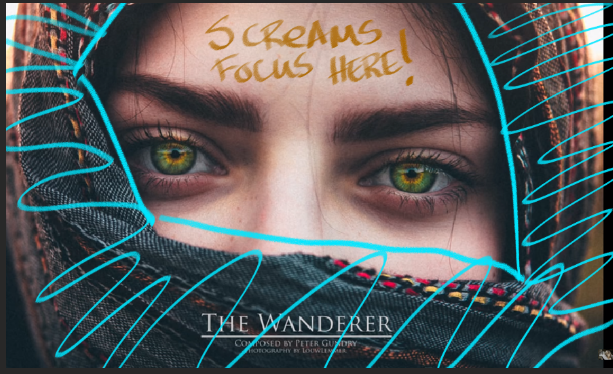We can get many things from studying a photograph. Texture, Anatomy, Material, Composition, Color Theory, Atmospheric perspective, and Mood just to name a few.
This is a close up portrait shot. And when a photographer works he/she uses many of the same communicative theories that we apply to digital paintings to give the viewer a focus.
Close up shots are very likely going to focus on the eyes.
Photography is limited, in a sense, if you've ever tried to compose with light.
Edit: Added
A camera has to "turn up the light" (to be simple) to get information from the shadows, which "blows out" the light.
It has to "turn the shadows way down" (again to be simple) to see information in the bright light, but lose information in the shadow in turn.
Since our focal point is in the eyes in your reference, its in the light part of the photo.
Therefore the darks are 'lost', as they have less information in them than the areas of light.
Which makes us focus where we are supposed to.
For Example here's a photo capturing the information in the bright light.

If it was the other way around we would see a very different picture.

However there is also HDR photography where you have to recognize that the photo has information in both light and dark.

Painting for a long time was the only thing that let us do this where we could see something that looked like it did in real life. Where we can focus on both light and dark. But for compositional purposes we want to control where the viewer looks so we would use these tools of losing information in darks or lights to make the viewer focus where we wanted to. To communicate what we want.
This is done purposefully for mood, and can depend on the setting, but it helps the composer tell the story.
Now that the lesson is out of the way. On to your study.
You've done a great job. Tons of detail can be hard and distracting but you really focused in here on what was important. The added strokes that you made add information and interest yes. But does it take away the purpose of the study? Ask yourself that question. "Did I take away from this photograph what the photographer wanted to communicate?"

Less information in the darks, saturated skin tones, duller complementary colors in the cloth that frames the face it tells our eyes "Look here!"
That's why we have instagram filters.

When we compare, we see that you've added information in the darks, actually made it duller colors in the focal point's shadow when it should be more saturated to attract our attention there. Then you have some warm colors on the cloth framing the face when they should be cooler to create contrast. This makes the face 'pop' with contrast more.
So quick airbrush paintover to illustrate the points here. Not a complete study by any means.

I think that about wraps it up. I think you learned a lot and should be proud of your work. Now you can look at life and photography more like a composing painter. Great job!